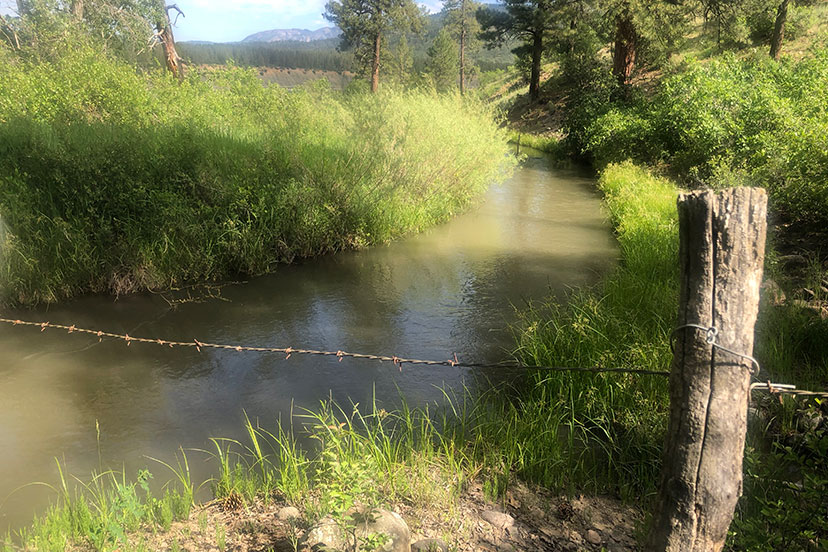PHOTO: The Park Ditch, north of downtown Pagosa Springs, running full on June 22, 2023.
We concluded Part One with a comment made by Archuleta County Commissioner Warren Brown, at the June 20 BOCC work session. Commissioner Brown was addressing his comments to former water commissioner Bob Formwwalt, but perhaps also, addressing his fellow commissioners, and maybe also the handful of people in the audience.
Commissioner Brown:
“Well, the whole point of my question was, this was an exceptional year, with the amount of water, generally we’re looking at…”
Mr. Formwalt:
“Yes, It’s a little bit above normal. Not a great deal…”
Commissioner Brown:
“I just think it’s time to start having serious discussions about the Dry Gulch Reservoir, again. Because we need the water storage. And we’ve seen what the demand on water has been. And it’s only going to continue.
“And efforts, like what you are making with the Park Ditch, will only go so far in routing the water, conserving the water, making sure everybody has the right to use it, who is a member [of the nonprofit Park Ditch Company].
The Archuleta County government is a minor shareholder in the Park Ditch Company. Very minor.
Commissioner Brown:
“But at the end of the day, as a community, if we don’t have enough water, we’re done. So, for the public’s sake, I think it’s… this is a topic that should be on the top of people’s list…”
Mr. Formwalt:
“Warren, I couldn’t agree with your more.”
County Commissioner Ronnie Maez:
“I was an advocate [for a Dry Gulch Reservoir] when it first started. I was ‘pro’ for it then, and we’d have been way ahead of the game if we’d have put it in, then. And every time we put it off, it just gets more and more expensive.”
What we have here is a curious conversation between three intelligent men, only one of whom might have more than an inkling about the complexities — legal, political, social, financial, geological — of building a reservoir on the Running Iron Ranch in the Dry Gulch valley.
On the political side of the issue, we have the fact that the Pagosa Area Water and Sanitation District (PAWSD) Board of Directors voted, in 2007, to purchase the Running Iron Ranch for $10 million (even though it was appraised at less than half that amount) as the site for a 35,000 acre-foot Dry Gulch Reservoir. The justification for the purchase? We were going to be facing a dire shortage of drinking water by 2020.
The Colorado Supreme Court, in an unprecedented ruling, tossed out the claim for water rights for such a large reservoir.
Following that Supreme Court ruling, the PAWSD customers have consistently elected Board members who are opposed to rushing ahead with a reservoir project, partly because the money to fund such a project is nowhere to be found.
The reservoir project was estimated to cost $357 million in 2009, when it was still envisioned at 35,000 acre-feet.
Another reason to avoid rushing ahead with the Dry Gulch Reservoir: no one has yet provided any evidence that the PAWSD customers need it.
Or want it.
Despite the lack of such evidence — of need, and want — a few people in the community have been working to make the reservoir a reality, and a number of them, as volunteers, sit on the Board of the San Juan Water Conservancy District (SJWCD), a taxpayer-funded district that typically spends its $90,000 annual budget to support environmental projects with, in some cases, no connection to the provision of drinking water.
Disclosure: I currently serve on the Pagosa Area Water and Sanitation District (PAWSD) board of directors, but this editorial reflects only my own personal opinions, and not necessarily those the PAWSD board as a whole.
Speaking as a volunteer member of the PAWSD Board of Directors, and as a journalist who has been researching and documenting water issues for the past 15 years, I have to smile at comments like the one made by Commissioner Brown on Tuesday.
That we are “done” if we don’t have enough water.
On May 26, the San Juan River was running at about 3,000 CFS (cubic feet per minute) through downtown Pagosa Springs.
That number means a lot to kayakers and rafting companies, because they understand — in a very hands-on way — what 3,000 CFS feels like.
To the rest of us, 3,000 CFS might not conjure up a great deal of meaning.
As a person interested in water resources and in the provision of municipal water to PAWSD customers, I probably have a slightly unusual perspective on the number 3,000 CFS.
If PAWSD had been able to divert all of the water flowing down the San Juan River on May 26, in order to collect enough water to serve our entire water district for an entire year, how long would it take to collect the 1,200 acre-feet of drinking water that PAWSD sells each year to its customers?
According to my pocket calculator, it would take about 90 seconds to collect all the water PAWSD needs for a year.
Following the BOCC’s Tuesday work session, when I listened to Commissioners Brown and Maez suggest that our community ought to move ahead, soon, with the construction of a reservoir on the Running Iron Ranch, I concluded that our two commissioners might not understand how much water PAWSD already has in storage, and how much water we are able to divert from the San Juan River.
There’s an expression my father was fond of using. “He’s talking through his hat.”
The meaning being, the person was talking about something he really knew nothing about.
I suppose we’re all guilty of talking through our hats, on occasion. Even if we’re elected officials.
To provide Commissioners Brown and Maez with information they might not have had access to, I shared a map I found on the SJWCD website…

